NURS1008 Project: Intergenerational Trauma and Nursing Practice
VerifiedAdded on 2023/01/07
|11
|3628
|81
Project
AI Summary
This NURS1008 project delves into the complex issue of intergenerational trauma within the context of Indigenous health in Australia. The project examines how historical trauma, including colonization, forced removals, and cultural loss, has led to lasting mental and physical health consequences for Indigenous communities. It explores the impact of intergenerational trauma, including symptoms of PTSD and its transmission across generations. The assignment analyzes the social determinants of health, such as biomedical risk factors, alcohol consumption, and socioeconomic factors, and their influence on Indigenous health outcomes. The Gibbs reflective cycle model is applied to demonstrate excellent knowledge and understanding of course content and applicability to professional nursing practice. The project highlights the importance of understanding the experiences of Indigenous Australians, addressing the social determinants of health, and developing culturally sensitive nursing practices to mitigate the effects of intergenerational trauma and promote healing and well-being. The project concludes by emphasizing the need for further research and interventions to address the ongoing challenges faced by Indigenous communities.
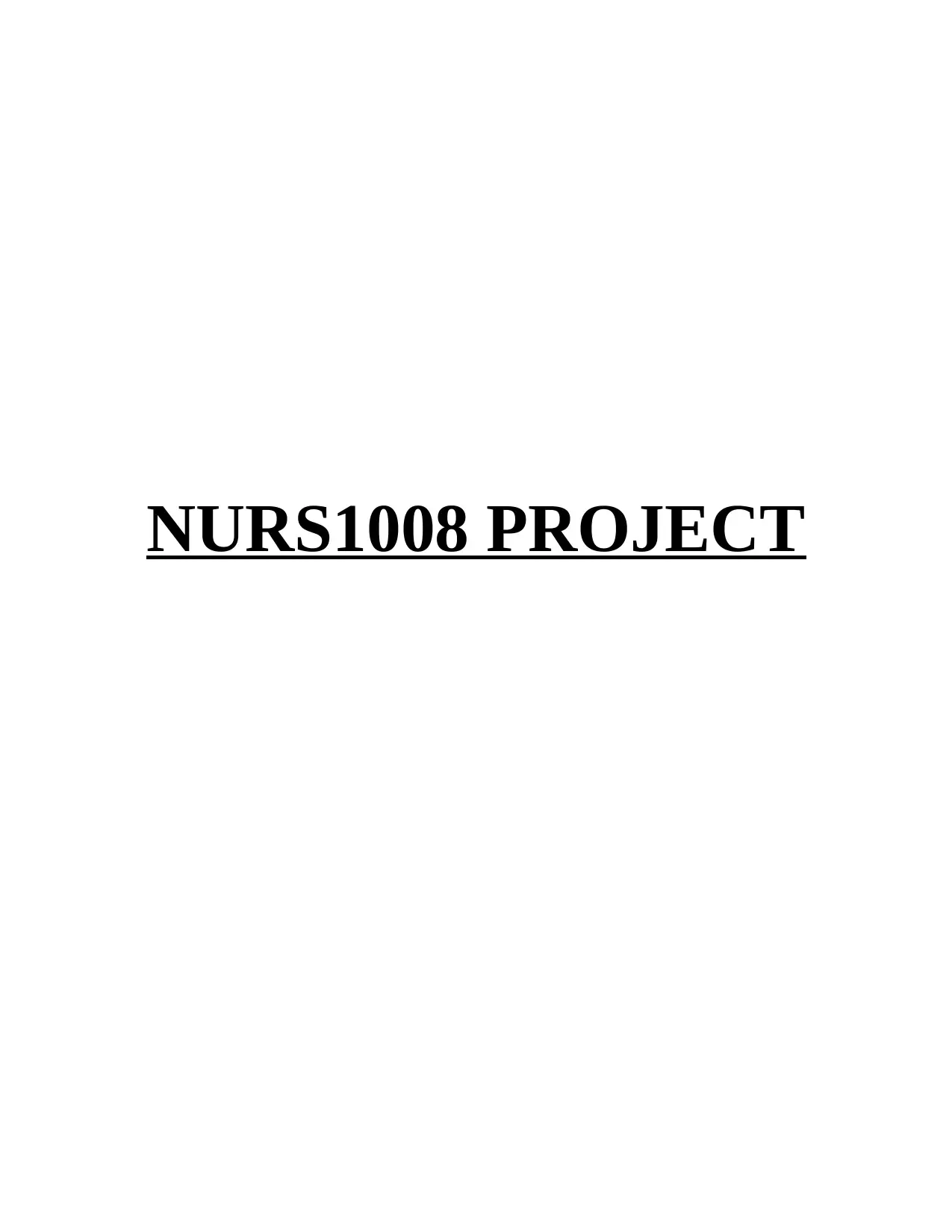
NURS1008 PROJECT
Paraphrase This Document
Need a fresh take? Get an instant paraphrase of this document with our AI Paraphraser
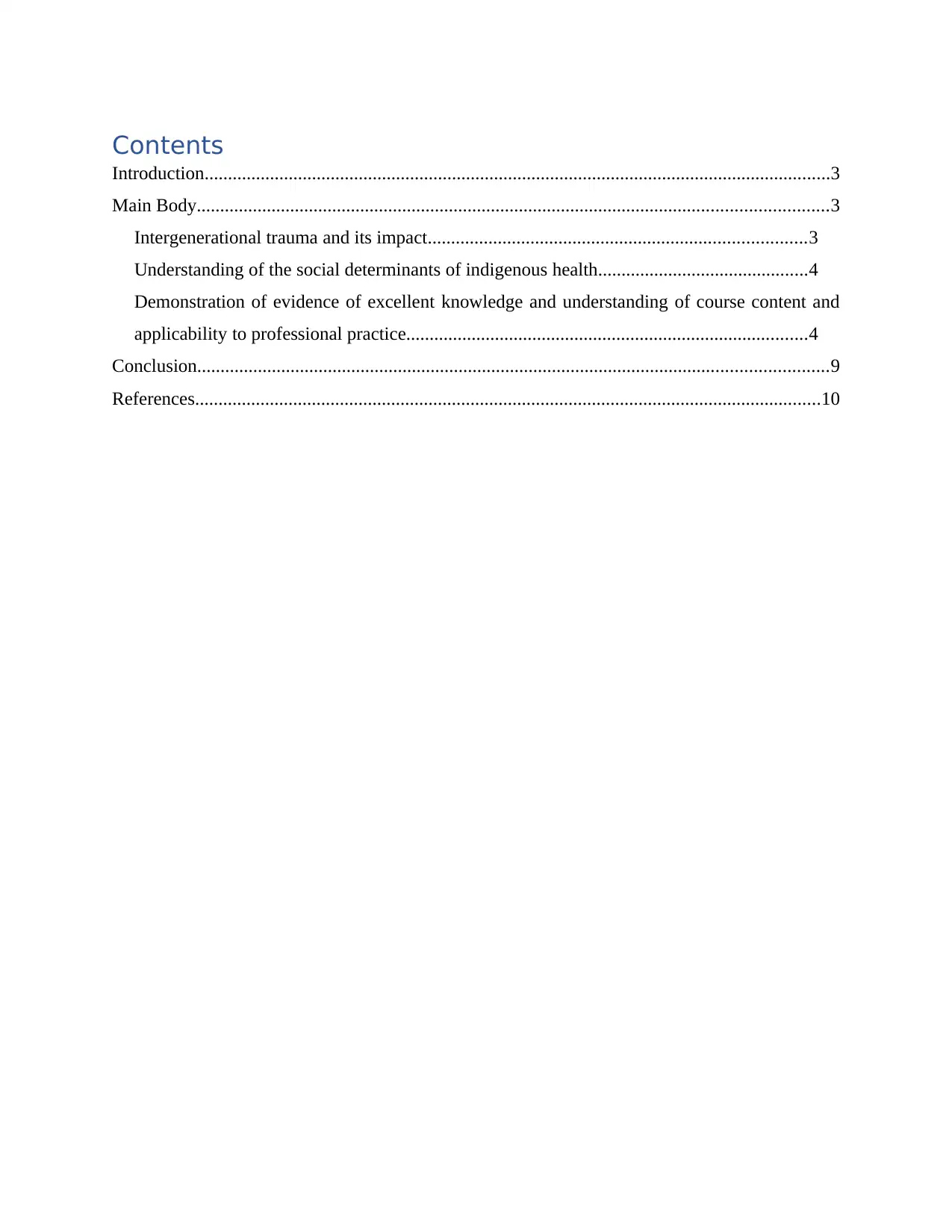
Contents
Introduction......................................................................................................................................3
Main Body.......................................................................................................................................3
Intergenerational trauma and its impact.................................................................................3
Understanding of the social determinants of indigenous health.............................................4
Demonstration of evidence of excellent knowledge and understanding of course content and
applicability to professional practice......................................................................................4
Conclusion.......................................................................................................................................9
References......................................................................................................................................10
Introduction......................................................................................................................................3
Main Body.......................................................................................................................................3
Intergenerational trauma and its impact.................................................................................3
Understanding of the social determinants of indigenous health.............................................4
Demonstration of evidence of excellent knowledge and understanding of course content and
applicability to professional practice......................................................................................4
Conclusion.......................................................................................................................................9
References......................................................................................................................................10
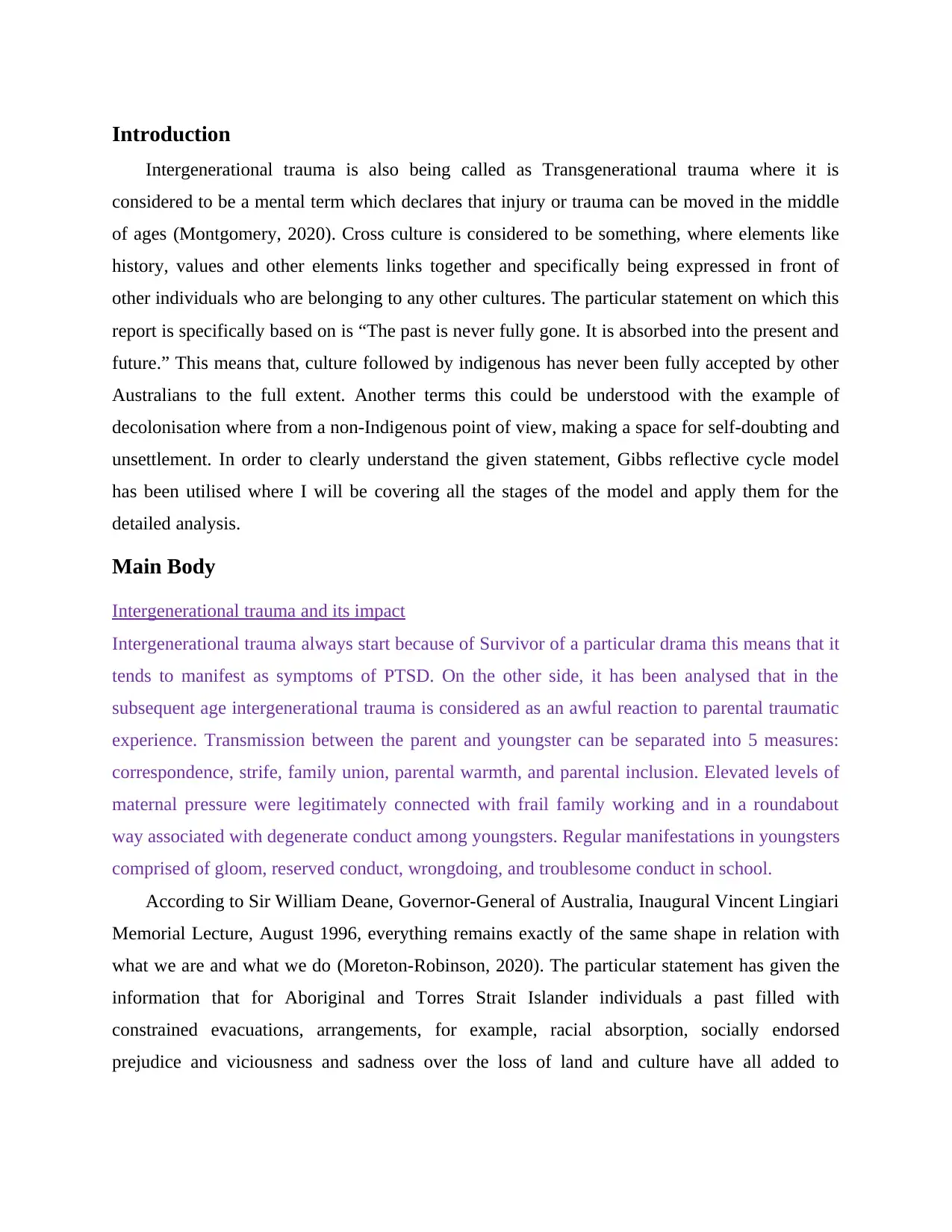
Introduction
Intergenerational trauma is also being called as Transgenerational trauma where it is
considered to be a mental term which declares that injury or trauma can be moved in the middle
of ages (Montgomery, 2020). Cross culture is considered to be something, where elements like
history, values and other elements links together and specifically being expressed in front of
other individuals who are belonging to any other cultures. The particular statement on which this
report is specifically based on is “The past is never fully gone. It is absorbed into the present and
future.” This means that, culture followed by indigenous has never been fully accepted by other
Australians to the full extent. Another terms this could be understood with the example of
decolonisation where from a non-Indigenous point of view, making a space for self-doubting and
unsettlement. In order to clearly understand the given statement, Gibbs reflective cycle model
has been utilised where I will be covering all the stages of the model and apply them for the
detailed analysis.
Main Body
Intergenerational trauma and its impact
Intergenerational trauma always start because of Survivor of a particular drama this means that it
tends to manifest as symptoms of PTSD. On the other side, it has been analysed that in the
subsequent age intergenerational trauma is considered as an awful reaction to parental traumatic
experience. Transmission between the parent and youngster can be separated into 5 measures:
correspondence, strife, family union, parental warmth, and parental inclusion. Elevated levels of
maternal pressure were legitimately connected with frail family working and in a roundabout
way associated with degenerate conduct among youngsters. Regular manifestations in youngsters
comprised of gloom, reserved conduct, wrongdoing, and troublesome conduct in school.
According to Sir William Deane, Governor-General of Australia, Inaugural Vincent Lingiari
Memorial Lecture, August 1996, everything remains exactly of the same shape in relation with
what we are and what we do (Moreton-Robinson, 2020). The particular statement has given the
information that for Aboriginal and Torres Strait Islander individuals a past filled with
constrained evacuations, arrangements, for example, racial absorption, socially endorsed
prejudice and viciousness and sadness over the loss of land and culture have all added to
Intergenerational trauma is also being called as Transgenerational trauma where it is
considered to be a mental term which declares that injury or trauma can be moved in the middle
of ages (Montgomery, 2020). Cross culture is considered to be something, where elements like
history, values and other elements links together and specifically being expressed in front of
other individuals who are belonging to any other cultures. The particular statement on which this
report is specifically based on is “The past is never fully gone. It is absorbed into the present and
future.” This means that, culture followed by indigenous has never been fully accepted by other
Australians to the full extent. Another terms this could be understood with the example of
decolonisation where from a non-Indigenous point of view, making a space for self-doubting and
unsettlement. In order to clearly understand the given statement, Gibbs reflective cycle model
has been utilised where I will be covering all the stages of the model and apply them for the
detailed analysis.
Main Body
Intergenerational trauma and its impact
Intergenerational trauma always start because of Survivor of a particular drama this means that it
tends to manifest as symptoms of PTSD. On the other side, it has been analysed that in the
subsequent age intergenerational trauma is considered as an awful reaction to parental traumatic
experience. Transmission between the parent and youngster can be separated into 5 measures:
correspondence, strife, family union, parental warmth, and parental inclusion. Elevated levels of
maternal pressure were legitimately connected with frail family working and in a roundabout
way associated with degenerate conduct among youngsters. Regular manifestations in youngsters
comprised of gloom, reserved conduct, wrongdoing, and troublesome conduct in school.
According to Sir William Deane, Governor-General of Australia, Inaugural Vincent Lingiari
Memorial Lecture, August 1996, everything remains exactly of the same shape in relation with
what we are and what we do (Moreton-Robinson, 2020). The particular statement has given the
information that for Aboriginal and Torres Strait Islander individuals a past filled with
constrained evacuations, arrangements, for example, racial absorption, socially endorsed
prejudice and viciousness and sadness over the loss of land and culture have all added to
⊘ This is a preview!⊘
Do you want full access?
Subscribe today to unlock all pages.

Trusted by 1+ million students worldwide
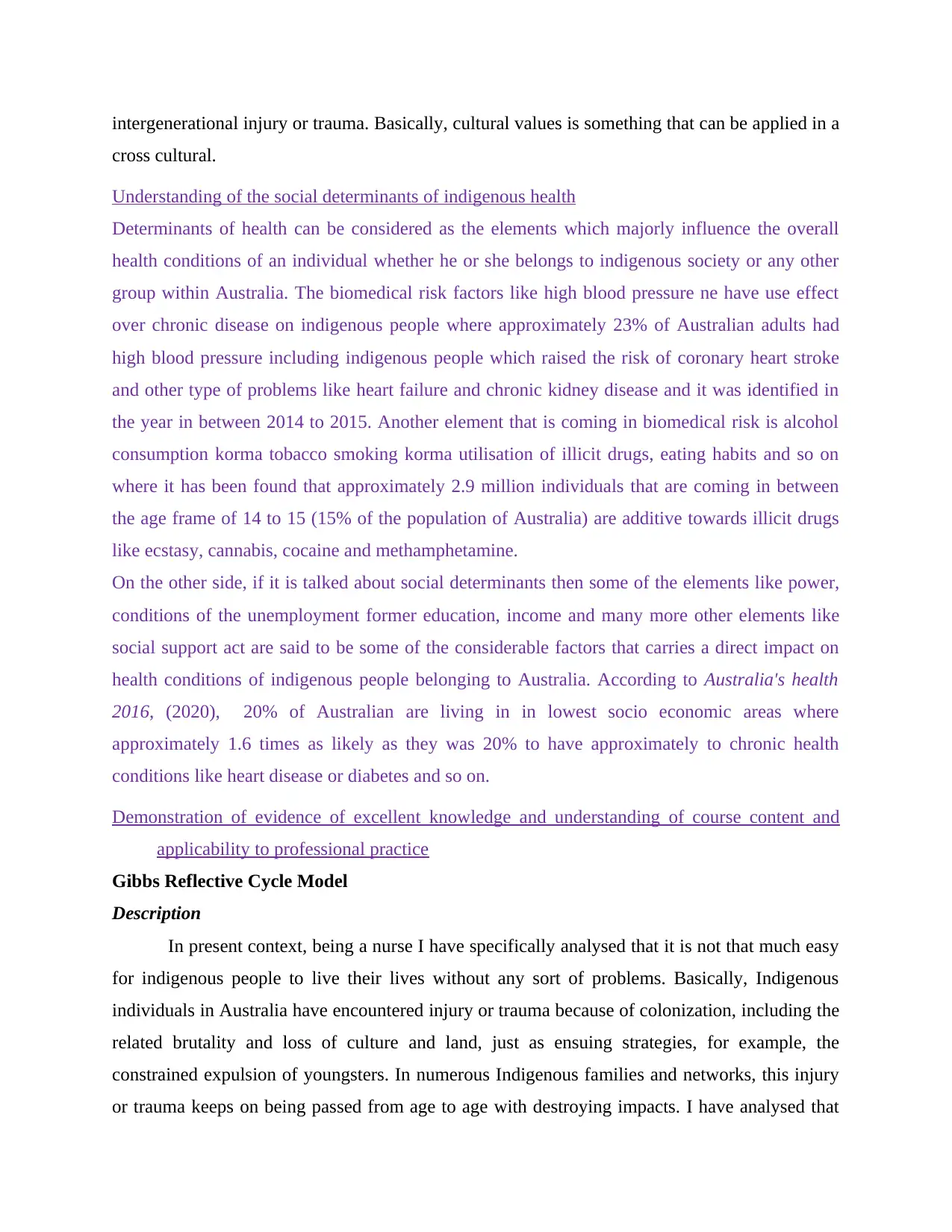
intergenerational injury or trauma. Basically, cultural values is something that can be applied in a
cross cultural.
Understanding of the social determinants of indigenous health
Determinants of health can be considered as the elements which majorly influence the overall
health conditions of an individual whether he or she belongs to indigenous society or any other
group within Australia. The biomedical risk factors like high blood pressure ne have use effect
over chronic disease on indigenous people where approximately 23% of Australian adults had
high blood pressure including indigenous people which raised the risk of coronary heart stroke
and other type of problems like heart failure and chronic kidney disease and it was identified in
the year in between 2014 to 2015. Another element that is coming in biomedical risk is alcohol
consumption korma tobacco smoking korma utilisation of illicit drugs, eating habits and so on
where it has been found that approximately 2.9 million individuals that are coming in between
the age frame of 14 to 15 (15% of the population of Australia) are additive towards illicit drugs
like ecstasy, cannabis, cocaine and methamphetamine.
On the other side, if it is talked about social determinants then some of the elements like power,
conditions of the unemployment former education, income and many more other elements like
social support act are said to be some of the considerable factors that carries a direct impact on
health conditions of indigenous people belonging to Australia. According to Australia's health
2016, (2020), 20% of Australian are living in in lowest socio economic areas where
approximately 1.6 times as likely as they was 20% to have approximately to chronic health
conditions like heart disease or diabetes and so on.
Demonstration of evidence of excellent knowledge and understanding of course content and
applicability to professional practice
Gibbs Reflective Cycle Model
Description
In present context, being a nurse I have specifically analysed that it is not that much easy
for indigenous people to live their lives without any sort of problems. Basically, Indigenous
individuals in Australia have encountered injury or trauma because of colonization, including the
related brutality and loss of culture and land, just as ensuing strategies, for example, the
constrained expulsion of youngsters. In numerous Indigenous families and networks, this injury
or trauma keeps on being passed from age to age with destroying impacts. I have analysed that
cross cultural.
Understanding of the social determinants of indigenous health
Determinants of health can be considered as the elements which majorly influence the overall
health conditions of an individual whether he or she belongs to indigenous society or any other
group within Australia. The biomedical risk factors like high blood pressure ne have use effect
over chronic disease on indigenous people where approximately 23% of Australian adults had
high blood pressure including indigenous people which raised the risk of coronary heart stroke
and other type of problems like heart failure and chronic kidney disease and it was identified in
the year in between 2014 to 2015. Another element that is coming in biomedical risk is alcohol
consumption korma tobacco smoking korma utilisation of illicit drugs, eating habits and so on
where it has been found that approximately 2.9 million individuals that are coming in between
the age frame of 14 to 15 (15% of the population of Australia) are additive towards illicit drugs
like ecstasy, cannabis, cocaine and methamphetamine.
On the other side, if it is talked about social determinants then some of the elements like power,
conditions of the unemployment former education, income and many more other elements like
social support act are said to be some of the considerable factors that carries a direct impact on
health conditions of indigenous people belonging to Australia. According to Australia's health
2016, (2020), 20% of Australian are living in in lowest socio economic areas where
approximately 1.6 times as likely as they was 20% to have approximately to chronic health
conditions like heart disease or diabetes and so on.
Demonstration of evidence of excellent knowledge and understanding of course content and
applicability to professional practice
Gibbs Reflective Cycle Model
Description
In present context, being a nurse I have specifically analysed that it is not that much easy
for indigenous people to live their lives without any sort of problems. Basically, Indigenous
individuals in Australia have encountered injury or trauma because of colonization, including the
related brutality and loss of culture and land, just as ensuing strategies, for example, the
constrained expulsion of youngsters. In numerous Indigenous families and networks, this injury
or trauma keeps on being passed from age to age with destroying impacts. I have analysed that
Paraphrase This Document
Need a fresh take? Get an instant paraphrase of this document with our AI Paraphraser
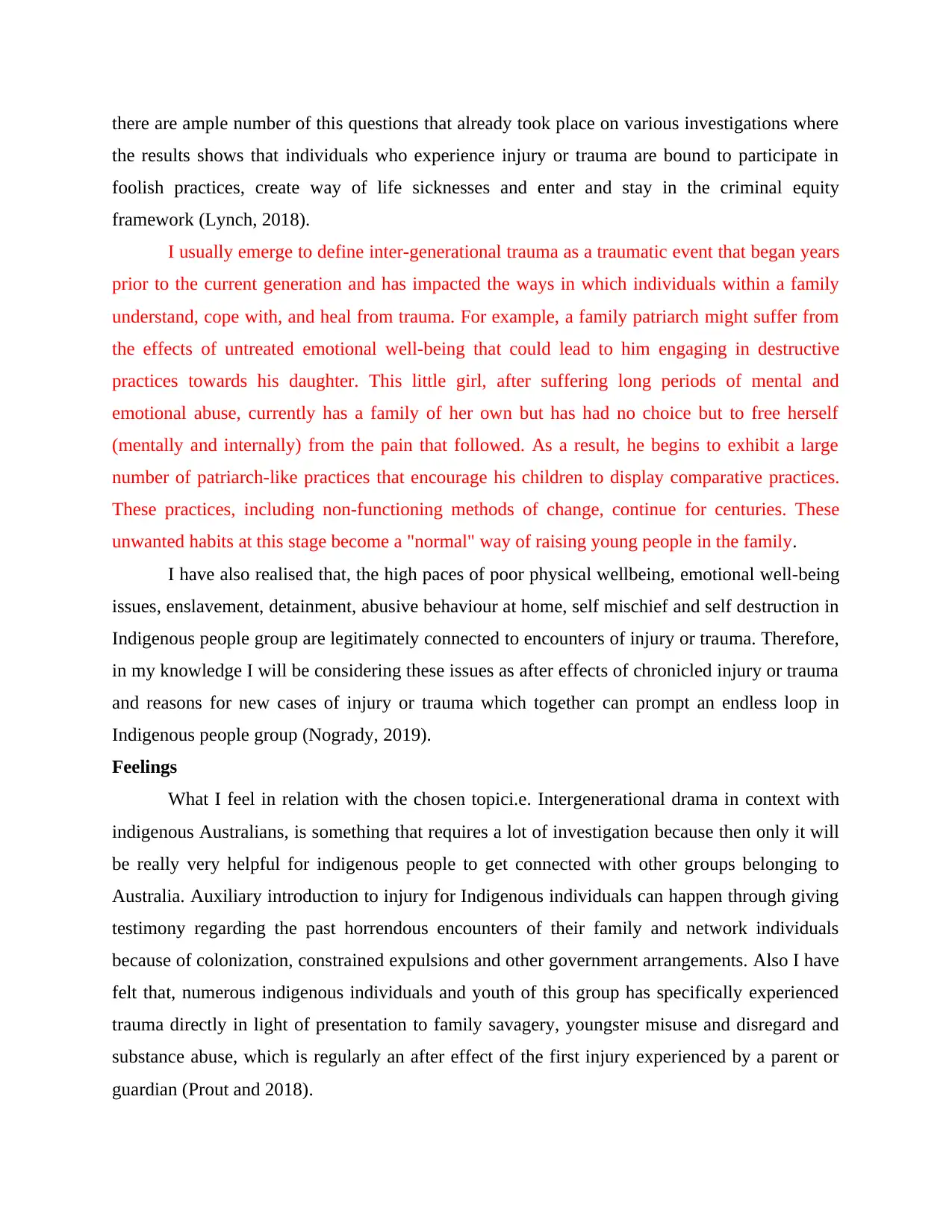
there are ample number of this questions that already took place on various investigations where
the results shows that individuals who experience injury or trauma are bound to participate in
foolish practices, create way of life sicknesses and enter and stay in the criminal equity
framework (Lynch, 2018).
I usually emerge to define inter-generational trauma as a traumatic event that began years
prior to the current generation and has impacted the ways in which individuals within a family
understand, cope with, and heal from trauma. For example, a family patriarch might suffer from
the effects of untreated emotional well-being that could lead to him engaging in destructive
practices towards his daughter. This little girl, after suffering long periods of mental and
emotional abuse, currently has a family of her own but has had no choice but to free herself
(mentally and internally) from the pain that followed. As a result, he begins to exhibit a large
number of patriarch-like practices that encourage his children to display comparative practices.
These practices, including non-functioning methods of change, continue for centuries. These
unwanted habits at this stage become a "normal" way of raising young people in the family.
I have also realised that, the high paces of poor physical wellbeing, emotional well-being
issues, enslavement, detainment, abusive behaviour at home, self mischief and self destruction in
Indigenous people group are legitimately connected to encounters of injury or trauma. Therefore,
in my knowledge I will be considering these issues as after effects of chronicled injury or trauma
and reasons for new cases of injury or trauma which together can prompt an endless loop in
Indigenous people group (Nogrady, 2019).
Feelings
What I feel in relation with the chosen topici.e. Intergenerational drama in context with
indigenous Australians, is something that requires a lot of investigation because then only it will
be really very helpful for indigenous people to get connected with other groups belonging to
Australia. Auxiliary introduction to injury for Indigenous individuals can happen through giving
testimony regarding the past horrendous encounters of their family and network individuals
because of colonization, constrained expulsions and other government arrangements. Also I have
felt that, numerous indigenous individuals and youth of this group has specifically experienced
trauma directly in light of presentation to family savagery, youngster misuse and disregard and
substance abuse, which is regularly an after effect of the first injury experienced by a parent or
guardian (Prout and 2018).
the results shows that individuals who experience injury or trauma are bound to participate in
foolish practices, create way of life sicknesses and enter and stay in the criminal equity
framework (Lynch, 2018).
I usually emerge to define inter-generational trauma as a traumatic event that began years
prior to the current generation and has impacted the ways in which individuals within a family
understand, cope with, and heal from trauma. For example, a family patriarch might suffer from
the effects of untreated emotional well-being that could lead to him engaging in destructive
practices towards his daughter. This little girl, after suffering long periods of mental and
emotional abuse, currently has a family of her own but has had no choice but to free herself
(mentally and internally) from the pain that followed. As a result, he begins to exhibit a large
number of patriarch-like practices that encourage his children to display comparative practices.
These practices, including non-functioning methods of change, continue for centuries. These
unwanted habits at this stage become a "normal" way of raising young people in the family.
I have also realised that, the high paces of poor physical wellbeing, emotional well-being
issues, enslavement, detainment, abusive behaviour at home, self mischief and self destruction in
Indigenous people group are legitimately connected to encounters of injury or trauma. Therefore,
in my knowledge I will be considering these issues as after effects of chronicled injury or trauma
and reasons for new cases of injury or trauma which together can prompt an endless loop in
Indigenous people group (Nogrady, 2019).
Feelings
What I feel in relation with the chosen topici.e. Intergenerational drama in context with
indigenous Australians, is something that requires a lot of investigation because then only it will
be really very helpful for indigenous people to get connected with other groups belonging to
Australia. Auxiliary introduction to injury for Indigenous individuals can happen through giving
testimony regarding the past horrendous encounters of their family and network individuals
because of colonization, constrained expulsions and other government arrangements. Also I have
felt that, numerous indigenous individuals and youth of this group has specifically experienced
trauma directly in light of presentation to family savagery, youngster misuse and disregard and
substance abuse, which is regularly an after effect of the first injury experienced by a parent or
guardian (Prout and 2018).
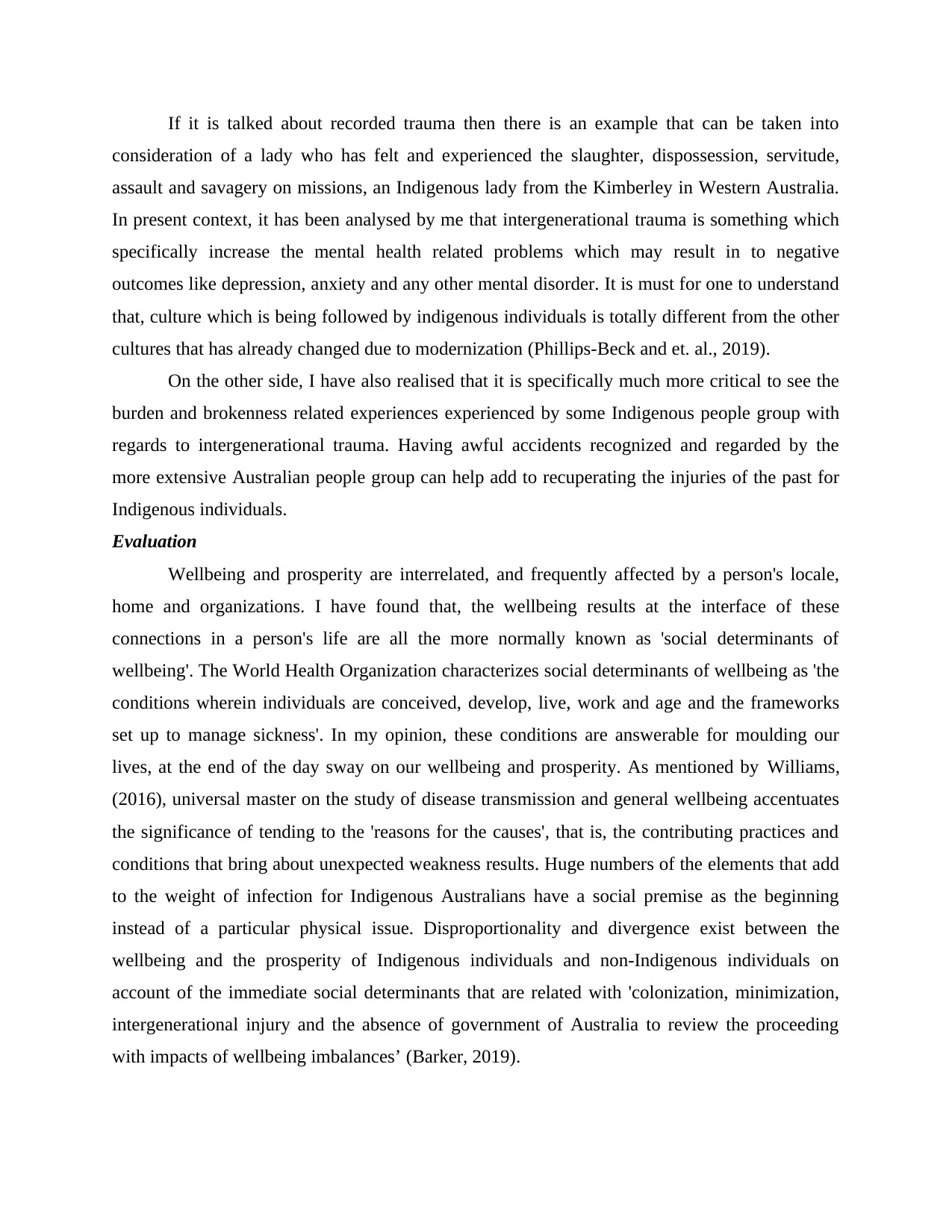
If it is talked about recorded trauma then there is an example that can be taken into
consideration of a lady who has felt and experienced the slaughter, dispossession, servitude,
assault and savagery on missions, an Indigenous lady from the Kimberley in Western Australia.
In present context, it has been analysed by me that intergenerational trauma is something which
specifically increase the mental health related problems which may result in to negative
outcomes like depression, anxiety and any other mental disorder. It is must for one to understand
that, culture which is being followed by indigenous individuals is totally different from the other
cultures that has already changed due to modernization (Phillips-Beck and et. al., 2019).
On the other side, I have also realised that it is specifically much more critical to see the
burden and brokenness related experiences experienced by some Indigenous people group with
regards to intergenerational trauma. Having awful accidents recognized and regarded by the
more extensive Australian people group can help add to recuperating the injuries of the past for
Indigenous individuals.
Evaluation
Wellbeing and prosperity are interrelated, and frequently affected by a person's locale,
home and organizations. I have found that, the wellbeing results at the interface of these
connections in a person's life are all the more normally known as 'social determinants of
wellbeing'. The World Health Organization characterizes social determinants of wellbeing as 'the
conditions wherein individuals are conceived, develop, live, work and age and the frameworks
set up to manage sickness'. In my opinion, these conditions are answerable for moulding our
lives, at the end of the day sway on our wellbeing and prosperity. As mentioned by Williams,
(2016), universal master on the study of disease transmission and general wellbeing accentuates
the significance of tending to the 'reasons for the causes', that is, the contributing practices and
conditions that bring about unexpected weakness results. Huge numbers of the elements that add
to the weight of infection for Indigenous Australians have a social premise as the beginning
instead of a particular physical issue. Disproportionality and divergence exist between the
wellbeing and the prosperity of Indigenous individuals and non-Indigenous individuals on
account of the immediate social determinants that are related with 'colonization, minimization,
intergenerational injury and the absence of government of Australia to review the proceeding
with impacts of wellbeing imbalances’ (Barker, 2019).
consideration of a lady who has felt and experienced the slaughter, dispossession, servitude,
assault and savagery on missions, an Indigenous lady from the Kimberley in Western Australia.
In present context, it has been analysed by me that intergenerational trauma is something which
specifically increase the mental health related problems which may result in to negative
outcomes like depression, anxiety and any other mental disorder. It is must for one to understand
that, culture which is being followed by indigenous individuals is totally different from the other
cultures that has already changed due to modernization (Phillips-Beck and et. al., 2019).
On the other side, I have also realised that it is specifically much more critical to see the
burden and brokenness related experiences experienced by some Indigenous people group with
regards to intergenerational trauma. Having awful accidents recognized and regarded by the
more extensive Australian people group can help add to recuperating the injuries of the past for
Indigenous individuals.
Evaluation
Wellbeing and prosperity are interrelated, and frequently affected by a person's locale,
home and organizations. I have found that, the wellbeing results at the interface of these
connections in a person's life are all the more normally known as 'social determinants of
wellbeing'. The World Health Organization characterizes social determinants of wellbeing as 'the
conditions wherein individuals are conceived, develop, live, work and age and the frameworks
set up to manage sickness'. In my opinion, these conditions are answerable for moulding our
lives, at the end of the day sway on our wellbeing and prosperity. As mentioned by Williams,
(2016), universal master on the study of disease transmission and general wellbeing accentuates
the significance of tending to the 'reasons for the causes', that is, the contributing practices and
conditions that bring about unexpected weakness results. Huge numbers of the elements that add
to the weight of infection for Indigenous Australians have a social premise as the beginning
instead of a particular physical issue. Disproportionality and divergence exist between the
wellbeing and the prosperity of Indigenous individuals and non-Indigenous individuals on
account of the immediate social determinants that are related with 'colonization, minimization,
intergenerational injury and the absence of government of Australia to review the proceeding
with impacts of wellbeing imbalances’ (Barker, 2019).
⊘ This is a preview!⊘
Do you want full access?
Subscribe today to unlock all pages.

Trusted by 1+ million students worldwide
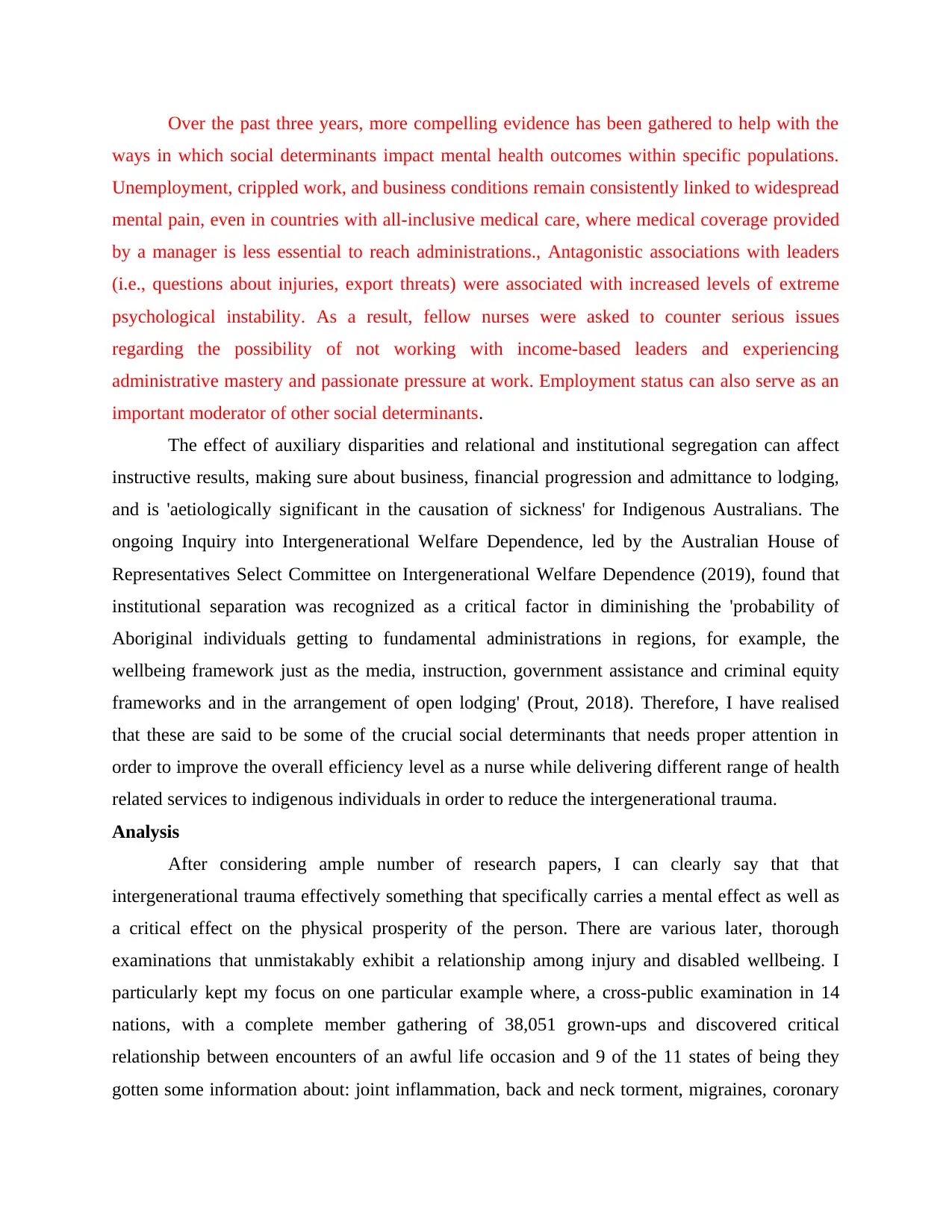
Over the past three years, more compelling evidence has been gathered to help with the
ways in which social determinants impact mental health outcomes within specific populations.
Unemployment, crippled work, and business conditions remain consistently linked to widespread
mental pain, even in countries with all-inclusive medical care, where medical coverage provided
by a manager is less essential to reach administrations., Antagonistic associations with leaders
(i.e., questions about injuries, export threats) were associated with increased levels of extreme
psychological instability. As a result, fellow nurses were asked to counter serious issues
regarding the possibility of not working with income-based leaders and experiencing
administrative mastery and passionate pressure at work. Employment status can also serve as an
important moderator of other social determinants.
The effect of auxiliary disparities and relational and institutional segregation can affect
instructive results, making sure about business, financial progression and admittance to lodging,
and is 'aetiologically significant in the causation of sickness' for Indigenous Australians. The
ongoing Inquiry into Intergenerational Welfare Dependence, led by the Australian House of
Representatives Select Committee on Intergenerational Welfare Dependence (2019), found that
institutional separation was recognized as a critical factor in diminishing the 'probability of
Aboriginal individuals getting to fundamental administrations in regions, for example, the
wellbeing framework just as the media, instruction, government assistance and criminal equity
frameworks and in the arrangement of open lodging' (Prout, 2018). Therefore, I have realised
that these are said to be some of the crucial social determinants that needs proper attention in
order to improve the overall efficiency level as a nurse while delivering different range of health
related services to indigenous individuals in order to reduce the intergenerational trauma.
Analysis
After considering ample number of research papers, I can clearly say that that
intergenerational trauma effectively something that specifically carries a mental effect as well as
a critical effect on the physical prosperity of the person. There are various later, thorough
examinations that unmistakably exhibit a relationship among injury and disabled wellbeing. I
particularly kept my focus on one particular example where, a cross-public examination in 14
nations, with a complete member gathering of 38,051 grown-ups and discovered critical
relationship between encounters of an awful life occasion and 9 of the 11 states of being they
gotten some information about: joint inflammation, back and neck torment, migraines, coronary
ways in which social determinants impact mental health outcomes within specific populations.
Unemployment, crippled work, and business conditions remain consistently linked to widespread
mental pain, even in countries with all-inclusive medical care, where medical coverage provided
by a manager is less essential to reach administrations., Antagonistic associations with leaders
(i.e., questions about injuries, export threats) were associated with increased levels of extreme
psychological instability. As a result, fellow nurses were asked to counter serious issues
regarding the possibility of not working with income-based leaders and experiencing
administrative mastery and passionate pressure at work. Employment status can also serve as an
important moderator of other social determinants.
The effect of auxiliary disparities and relational and institutional segregation can affect
instructive results, making sure about business, financial progression and admittance to lodging,
and is 'aetiologically significant in the causation of sickness' for Indigenous Australians. The
ongoing Inquiry into Intergenerational Welfare Dependence, led by the Australian House of
Representatives Select Committee on Intergenerational Welfare Dependence (2019), found that
institutional separation was recognized as a critical factor in diminishing the 'probability of
Aboriginal individuals getting to fundamental administrations in regions, for example, the
wellbeing framework just as the media, instruction, government assistance and criminal equity
frameworks and in the arrangement of open lodging' (Prout, 2018). Therefore, I have realised
that these are said to be some of the crucial social determinants that needs proper attention in
order to improve the overall efficiency level as a nurse while delivering different range of health
related services to indigenous individuals in order to reduce the intergenerational trauma.
Analysis
After considering ample number of research papers, I can clearly say that that
intergenerational trauma effectively something that specifically carries a mental effect as well as
a critical effect on the physical prosperity of the person. There are various later, thorough
examinations that unmistakably exhibit a relationship among injury and disabled wellbeing. I
particularly kept my focus on one particular example where, a cross-public examination in 14
nations, with a complete member gathering of 38,051 grown-ups and discovered critical
relationship between encounters of an awful life occasion and 9 of the 11 states of being they
gotten some information about: joint inflammation, back and neck torment, migraines, coronary
Paraphrase This Document
Need a fresh take? Get an instant paraphrase of this document with our AI Paraphraser
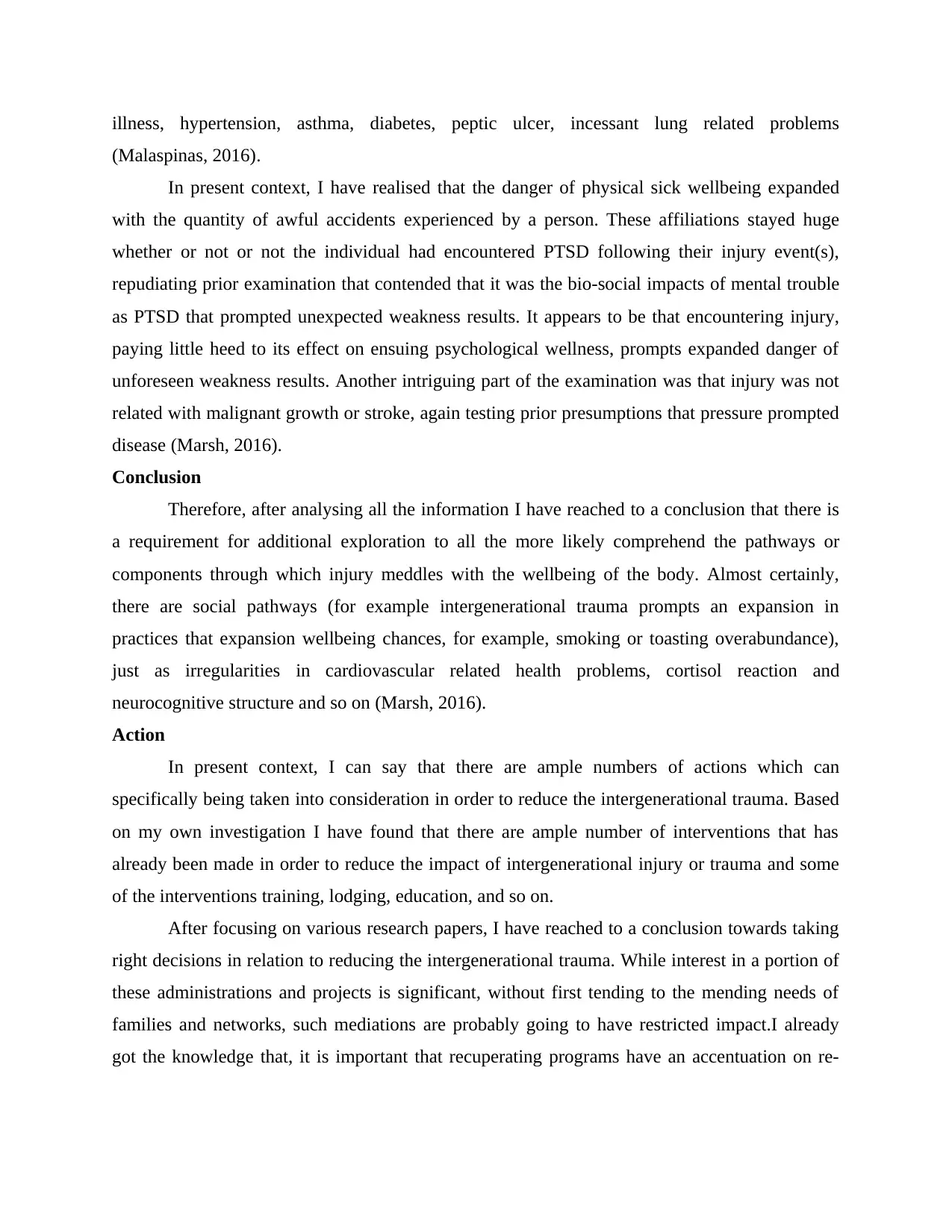
illness, hypertension, asthma, diabetes, peptic ulcer, incessant lung related problems
(Malaspinas, 2016).
In present context, I have realised that the danger of physical sick wellbeing expanded
with the quantity of awful accidents experienced by a person. These affiliations stayed huge
whether or not or not the individual had encountered PTSD following their injury event(s),
repudiating prior examination that contended that it was the bio-social impacts of mental trouble
as PTSD that prompted unexpected weakness results. It appears to be that encountering injury,
paying little heed to its effect on ensuing psychological wellness, prompts expanded danger of
unforeseen weakness results. Another intriguing part of the examination was that injury was not
related with malignant growth or stroke, again testing prior presumptions that pressure prompted
disease (Marsh, 2016).
Conclusion
Therefore, after analysing all the information I have reached to a conclusion that there is
a requirement for additional exploration to all the more likely comprehend the pathways or
components through which injury meddles with the wellbeing of the body. Almost certainly,
there are social pathways (for example intergenerational trauma prompts an expansion in
practices that expansion wellbeing chances, for example, smoking or toasting overabundance),
just as irregularities in cardiovascular related health problems, cortisol reaction and
neurocognitive structure and so on (Marsh, 2016).
Action
In present context, I can say that there are ample numbers of actions which can
specifically being taken into consideration in order to reduce the intergenerational trauma. Based
on my own investigation I have found that there are ample number of interventions that has
already been made in order to reduce the impact of intergenerational injury or trauma and some
of the interventions training, lodging, education, and so on.
After focusing on various research papers, I have reached to a conclusion towards taking
right decisions in relation to reducing the intergenerational trauma. While interest in a portion of
these administrations and projects is significant, without first tending to the mending needs of
families and networks, such mediations are probably going to have restricted impact.I already
got the knowledge that, it is important that recuperating programs have an accentuation on re-
(Malaspinas, 2016).
In present context, I have realised that the danger of physical sick wellbeing expanded
with the quantity of awful accidents experienced by a person. These affiliations stayed huge
whether or not or not the individual had encountered PTSD following their injury event(s),
repudiating prior examination that contended that it was the bio-social impacts of mental trouble
as PTSD that prompted unexpected weakness results. It appears to be that encountering injury,
paying little heed to its effect on ensuing psychological wellness, prompts expanded danger of
unforeseen weakness results. Another intriguing part of the examination was that injury was not
related with malignant growth or stroke, again testing prior presumptions that pressure prompted
disease (Marsh, 2016).
Conclusion
Therefore, after analysing all the information I have reached to a conclusion that there is
a requirement for additional exploration to all the more likely comprehend the pathways or
components through which injury meddles with the wellbeing of the body. Almost certainly,
there are social pathways (for example intergenerational trauma prompts an expansion in
practices that expansion wellbeing chances, for example, smoking or toasting overabundance),
just as irregularities in cardiovascular related health problems, cortisol reaction and
neurocognitive structure and so on (Marsh, 2016).
Action
In present context, I can say that there are ample numbers of actions which can
specifically being taken into consideration in order to reduce the intergenerational trauma. Based
on my own investigation I have found that there are ample number of interventions that has
already been made in order to reduce the impact of intergenerational injury or trauma and some
of the interventions training, lodging, education, and so on.
After focusing on various research papers, I have reached to a conclusion towards taking
right decisions in relation to reducing the intergenerational trauma. While interest in a portion of
these administrations and projects is significant, without first tending to the mending needs of
families and networks, such mediations are probably going to have restricted impact.I already
got the knowledge that, it is important that recuperating programs have an accentuation on re-
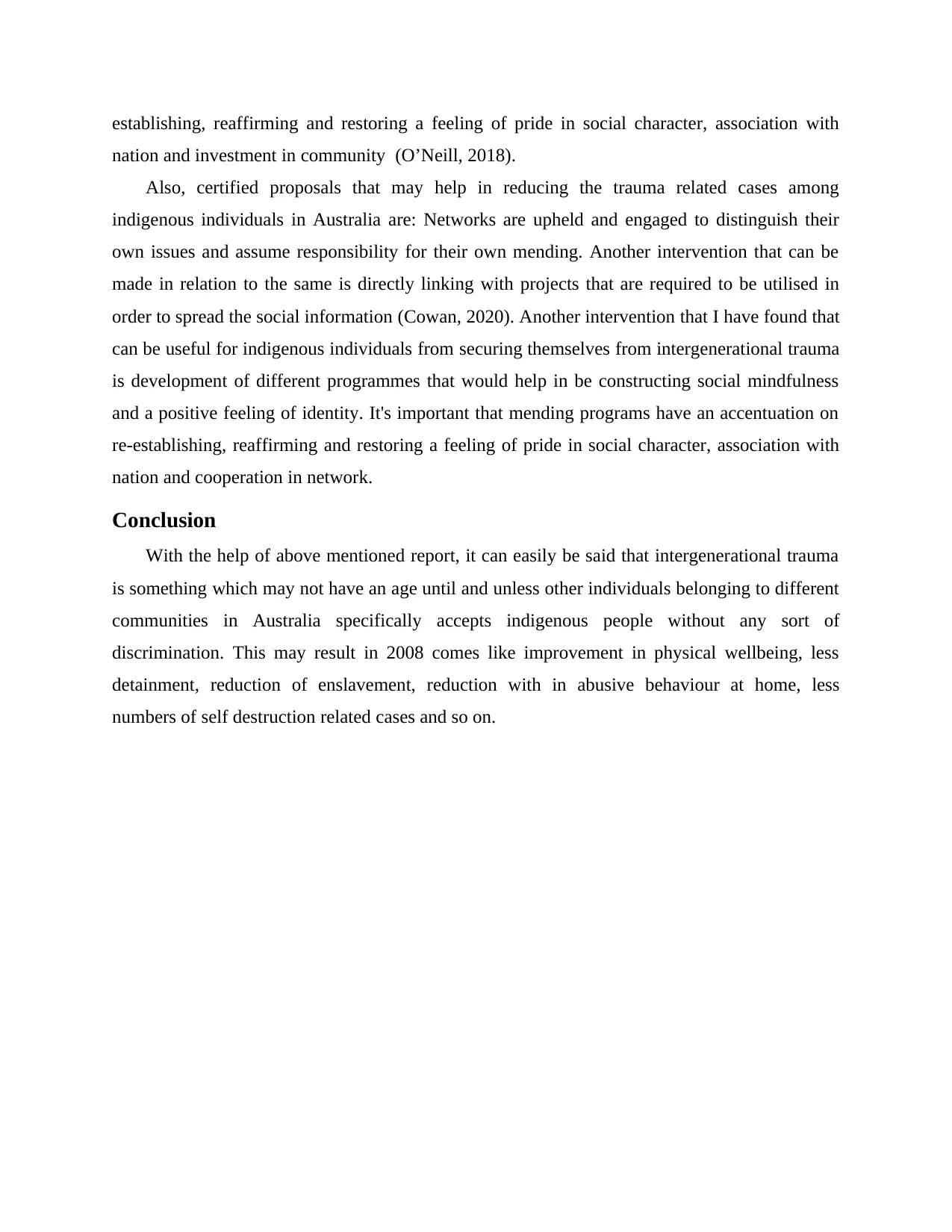
establishing, reaffirming and restoring a feeling of pride in social character, association with
nation and investment in community (O’Neill, 2018).
Also, certified proposals that may help in reducing the trauma related cases among
indigenous individuals in Australia are: Networks are upheld and engaged to distinguish their
own issues and assume responsibility for their own mending. Another intervention that can be
made in relation to the same is directly linking with projects that are required to be utilised in
order to spread the social information (Cowan, 2020). Another intervention that I have found that
can be useful for indigenous individuals from securing themselves from intergenerational trauma
is development of different programmes that would help in be constructing social mindfulness
and a positive feeling of identity. It's important that mending programs have an accentuation on
re-establishing, reaffirming and restoring a feeling of pride in social character, association with
nation and cooperation in network.
Conclusion
With the help of above mentioned report, it can easily be said that intergenerational trauma
is something which may not have an age until and unless other individuals belonging to different
communities in Australia specifically accepts indigenous people without any sort of
discrimination. This may result in 2008 comes like improvement in physical wellbeing, less
detainment, reduction of enslavement, reduction with in abusive behaviour at home, less
numbers of self destruction related cases and so on.
nation and investment in community (O’Neill, 2018).
Also, certified proposals that may help in reducing the trauma related cases among
indigenous individuals in Australia are: Networks are upheld and engaged to distinguish their
own issues and assume responsibility for their own mending. Another intervention that can be
made in relation to the same is directly linking with projects that are required to be utilised in
order to spread the social information (Cowan, 2020). Another intervention that I have found that
can be useful for indigenous individuals from securing themselves from intergenerational trauma
is development of different programmes that would help in be constructing social mindfulness
and a positive feeling of identity. It's important that mending programs have an accentuation on
re-establishing, reaffirming and restoring a feeling of pride in social character, association with
nation and cooperation in network.
Conclusion
With the help of above mentioned report, it can easily be said that intergenerational trauma
is something which may not have an age until and unless other individuals belonging to different
communities in Australia specifically accepts indigenous people without any sort of
discrimination. This may result in 2008 comes like improvement in physical wellbeing, less
detainment, reduction of enslavement, reduction with in abusive behaviour at home, less
numbers of self destruction related cases and so on.
⊘ This is a preview!⊘
Do you want full access?
Subscribe today to unlock all pages.

Trusted by 1+ million students worldwide
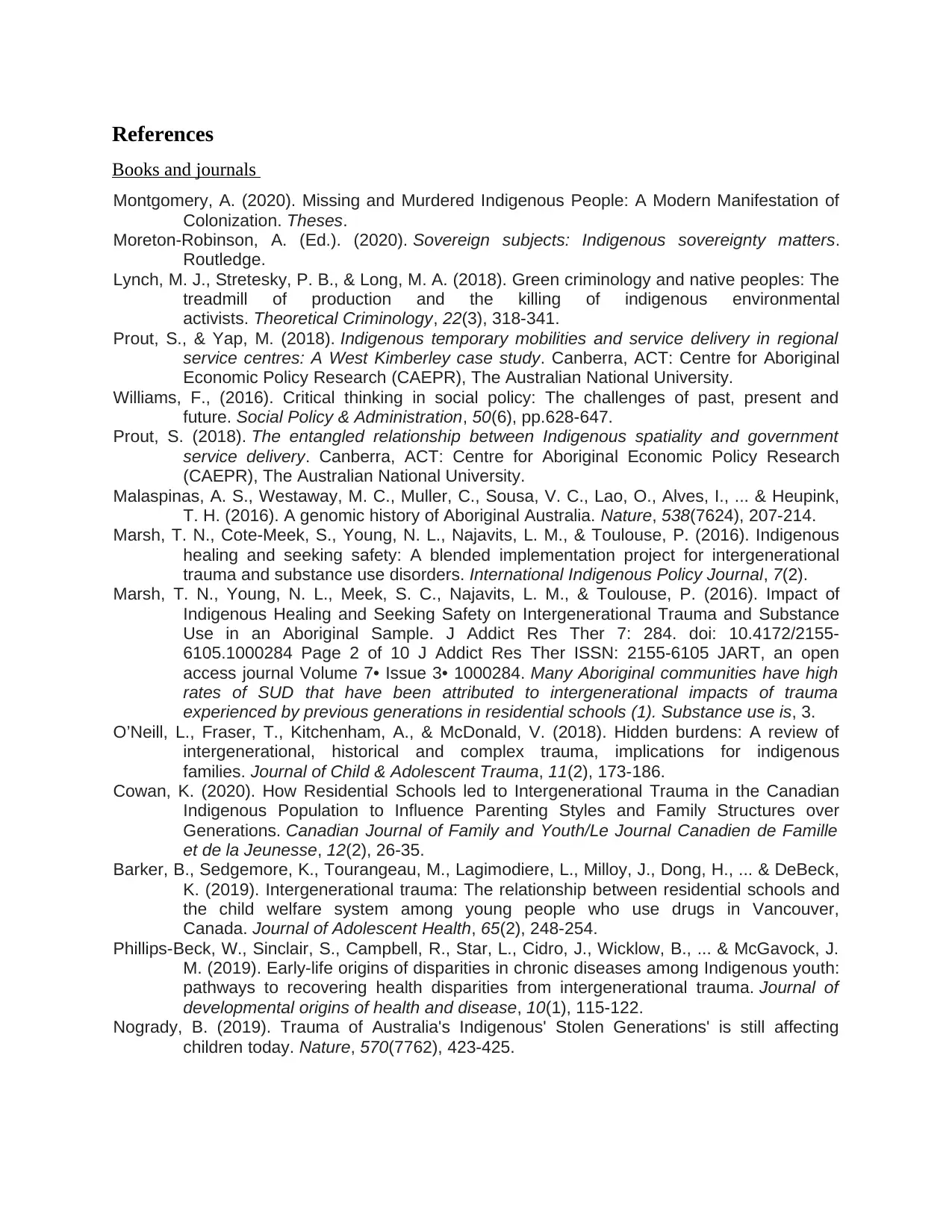
References
Books and journals
Montgomery, A. (2020). Missing and Murdered Indigenous People: A Modern Manifestation of
Colonization. Theses.
Moreton-Robinson, A. (Ed.). (2020). Sovereign subjects: Indigenous sovereignty matters.
Routledge.
Lynch, M. J., Stretesky, P. B., & Long, M. A. (2018). Green criminology and native peoples: The
treadmill of production and the killing of indigenous environmental
activists. Theoretical Criminology, 22(3), 318-341.
Prout, S., & Yap, M. (2018). Indigenous temporary mobilities and service delivery in regional
service centres: A West Kimberley case study. Canberra, ACT: Centre for Aboriginal
Economic Policy Research (CAEPR), The Australian National University.
Williams, F., (2016). Critical thinking in social policy: The challenges of past, present and
future. Social Policy & Administration, 50(6), pp.628-647.
Prout, S. (2018). The entangled relationship between Indigenous spatiality and government
service delivery. Canberra, ACT: Centre for Aboriginal Economic Policy Research
(CAEPR), The Australian National University.
Malaspinas, A. S., Westaway, M. C., Muller, C., Sousa, V. C., Lao, O., Alves, I., ... & Heupink,
T. H. (2016). A genomic history of Aboriginal Australia. Nature, 538(7624), 207-214.
Marsh, T. N., Cote-Meek, S., Young, N. L., Najavits, L. M., & Toulouse, P. (2016). Indigenous
healing and seeking safety: A blended implementation project for intergenerational
trauma and substance use disorders. International Indigenous Policy Journal, 7(2).
Marsh, T. N., Young, N. L., Meek, S. C., Najavits, L. M., & Toulouse, P. (2016). Impact of
Indigenous Healing and Seeking Safety on Intergenerational Trauma and Substance
Use in an Aboriginal Sample. J Addict Res Ther 7: 284. doi: 10.4172/2155-
6105.1000284 Page 2 of 10 J Addict Res Ther ISSN: 2155-6105 JART, an open
access journal Volume 7• Issue 3• 1000284. Many Aboriginal communities have high
rates of SUD that have been attributed to intergenerational impacts of trauma
experienced by previous generations in residential schools (1). Substance use is, 3.
O’Neill, L., Fraser, T., Kitchenham, A., & McDonald, V. (2018). Hidden burdens: A review of
intergenerational, historical and complex trauma, implications for indigenous
families. Journal of Child & Adolescent Trauma, 11(2), 173-186.
Cowan, K. (2020). How Residential Schools led to Intergenerational Trauma in the Canadian
Indigenous Population to Influence Parenting Styles and Family Structures over
Generations. Canadian Journal of Family and Youth/Le Journal Canadien de Famille
et de la Jeunesse, 12(2), 26-35.
Barker, B., Sedgemore, K., Tourangeau, M., Lagimodiere, L., Milloy, J., Dong, H., ... & DeBeck,
K. (2019). Intergenerational trauma: The relationship between residential schools and
the child welfare system among young people who use drugs in Vancouver,
Canada. Journal of Adolescent Health, 65(2), 248-254.
Phillips-Beck, W., Sinclair, S., Campbell, R., Star, L., Cidro, J., Wicklow, B., ... & McGavock, J.
M. (2019). Early-life origins of disparities in chronic diseases among Indigenous youth:
pathways to recovering health disparities from intergenerational trauma. Journal of
developmental origins of health and disease, 10(1), 115-122.
Nogrady, B. (2019). Trauma of Australia's Indigenous' Stolen Generations' is still affecting
children today. Nature, 570(7762), 423-425.
Books and journals
Montgomery, A. (2020). Missing and Murdered Indigenous People: A Modern Manifestation of
Colonization. Theses.
Moreton-Robinson, A. (Ed.). (2020). Sovereign subjects: Indigenous sovereignty matters.
Routledge.
Lynch, M. J., Stretesky, P. B., & Long, M. A. (2018). Green criminology and native peoples: The
treadmill of production and the killing of indigenous environmental
activists. Theoretical Criminology, 22(3), 318-341.
Prout, S., & Yap, M. (2018). Indigenous temporary mobilities and service delivery in regional
service centres: A West Kimberley case study. Canberra, ACT: Centre for Aboriginal
Economic Policy Research (CAEPR), The Australian National University.
Williams, F., (2016). Critical thinking in social policy: The challenges of past, present and
future. Social Policy & Administration, 50(6), pp.628-647.
Prout, S. (2018). The entangled relationship between Indigenous spatiality and government
service delivery. Canberra, ACT: Centre for Aboriginal Economic Policy Research
(CAEPR), The Australian National University.
Malaspinas, A. S., Westaway, M. C., Muller, C., Sousa, V. C., Lao, O., Alves, I., ... & Heupink,
T. H. (2016). A genomic history of Aboriginal Australia. Nature, 538(7624), 207-214.
Marsh, T. N., Cote-Meek, S., Young, N. L., Najavits, L. M., & Toulouse, P. (2016). Indigenous
healing and seeking safety: A blended implementation project for intergenerational
trauma and substance use disorders. International Indigenous Policy Journal, 7(2).
Marsh, T. N., Young, N. L., Meek, S. C., Najavits, L. M., & Toulouse, P. (2016). Impact of
Indigenous Healing and Seeking Safety on Intergenerational Trauma and Substance
Use in an Aboriginal Sample. J Addict Res Ther 7: 284. doi: 10.4172/2155-
6105.1000284 Page 2 of 10 J Addict Res Ther ISSN: 2155-6105 JART, an open
access journal Volume 7• Issue 3• 1000284. Many Aboriginal communities have high
rates of SUD that have been attributed to intergenerational impacts of trauma
experienced by previous generations in residential schools (1). Substance use is, 3.
O’Neill, L., Fraser, T., Kitchenham, A., & McDonald, V. (2018). Hidden burdens: A review of
intergenerational, historical and complex trauma, implications for indigenous
families. Journal of Child & Adolescent Trauma, 11(2), 173-186.
Cowan, K. (2020). How Residential Schools led to Intergenerational Trauma in the Canadian
Indigenous Population to Influence Parenting Styles and Family Structures over
Generations. Canadian Journal of Family and Youth/Le Journal Canadien de Famille
et de la Jeunesse, 12(2), 26-35.
Barker, B., Sedgemore, K., Tourangeau, M., Lagimodiere, L., Milloy, J., Dong, H., ... & DeBeck,
K. (2019). Intergenerational trauma: The relationship between residential schools and
the child welfare system among young people who use drugs in Vancouver,
Canada. Journal of Adolescent Health, 65(2), 248-254.
Phillips-Beck, W., Sinclair, S., Campbell, R., Star, L., Cidro, J., Wicklow, B., ... & McGavock, J.
M. (2019). Early-life origins of disparities in chronic diseases among Indigenous youth:
pathways to recovering health disparities from intergenerational trauma. Journal of
developmental origins of health and disease, 10(1), 115-122.
Nogrady, B. (2019). Trauma of Australia's Indigenous' Stolen Generations' is still affecting
children today. Nature, 570(7762), 423-425.
Paraphrase This Document
Need a fresh take? Get an instant paraphrase of this document with our AI Paraphraser
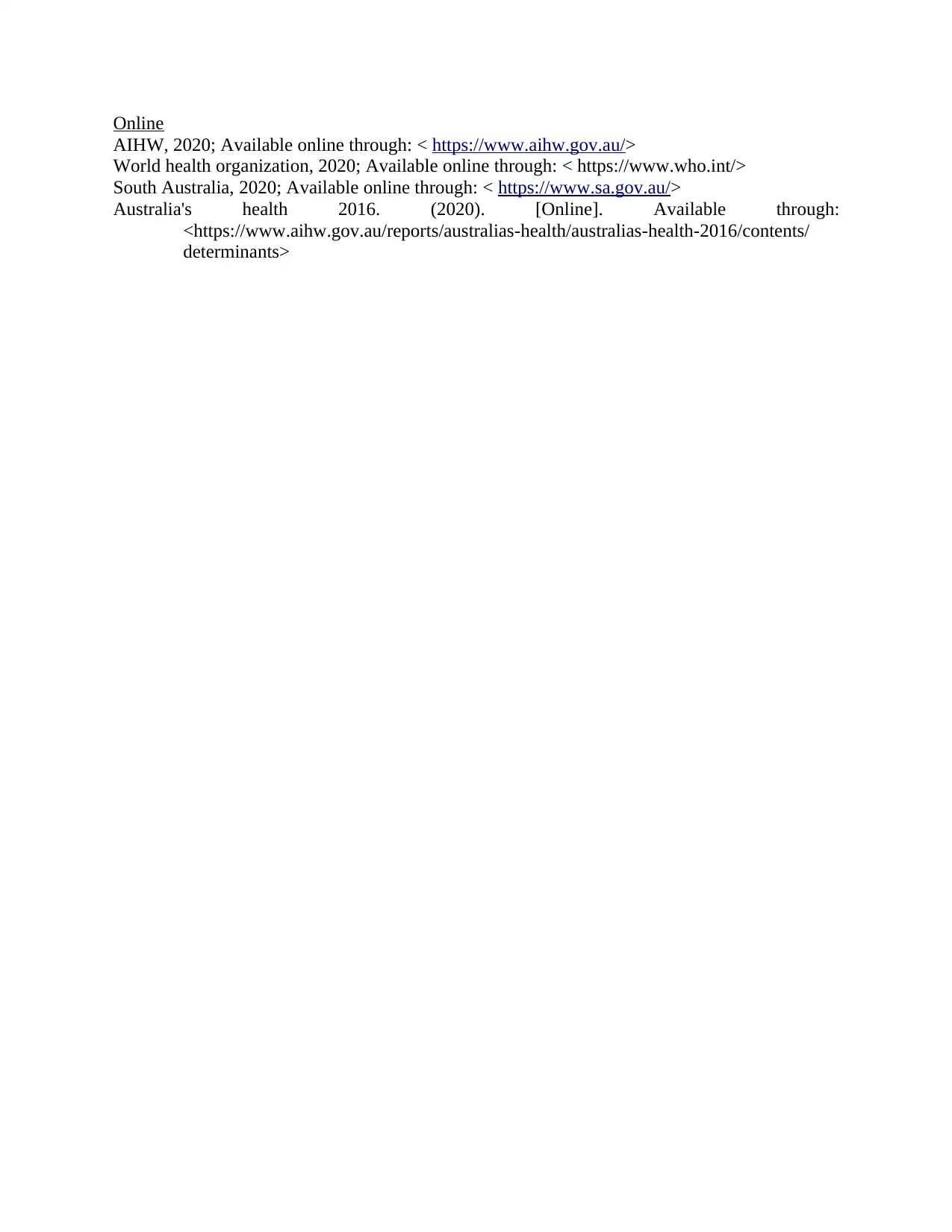
Online
AIHW, 2020; Available online through: < https://www.aihw.gov.au/>
World health organization, 2020; Available online through: < https://www.who.int/>
South Australia, 2020; Available online through: < https://www.sa.gov.au/>
Australia's health 2016. (2020). [Online]. Available through:
<https://www.aihw.gov.au/reports/australias-health/australias-health-2016/contents/
determinants>
AIHW, 2020; Available online through: < https://www.aihw.gov.au/>
World health organization, 2020; Available online through: < https://www.who.int/>
South Australia, 2020; Available online through: < https://www.sa.gov.au/>
Australia's health 2016. (2020). [Online]. Available through:
<https://www.aihw.gov.au/reports/australias-health/australias-health-2016/contents/
determinants>
1 out of 11
Your All-in-One AI-Powered Toolkit for Academic Success.
+13062052269
info@desklib.com
Available 24*7 on WhatsApp / Email
![[object Object]](/_next/static/media/star-bottom.7253800d.svg)
Unlock your academic potential
Copyright © 2020–2025 A2Z Services. All Rights Reserved. Developed and managed by ZUCOL.